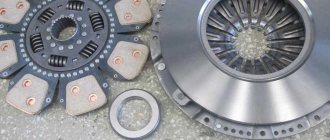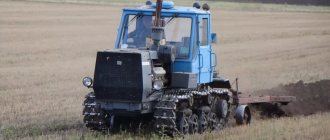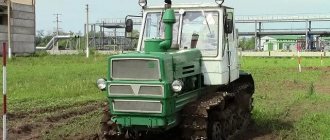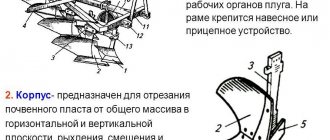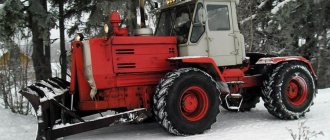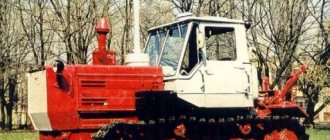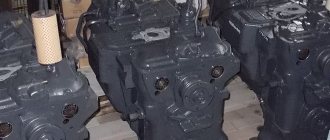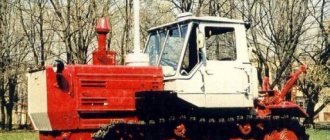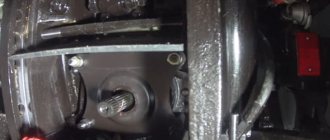During the Soviet era, great attention was paid to the development and production of special equipment. Therefore, the T-150 tractor, the creation of which began precisely in those years, is distinguished by its exceptional reliability and unpretentiousness, and is suitable for use in different climatic zones. The T-150 tractor is designed to solve a wide range of tasks in agriculture, road construction and maintenance, logging and other industries, including the armed forces.
The T-150 wheeled tractor is also maximally unified with the T-150 tracked model in terms of a wide range of components and parts. The design and production of a family of two machines is associated with a number of technological and design difficulties. At the same time, this allows us to reduce the cost of providing equipment with spare parts, consumables and components. This approach is used by John Deere, which produces both the 8120 and 8120T models.
History of the creation of the T-150 tractor
The production of this model was mastered by the Kharkov Tractor Plant more than 40 years ago. The first T-150 tractor left the assembly line in 1971 much earlier than the tracked modification. It is the wheeled vehicles of this manufacturer that are most widespread in the national economy. The prototype for the creation of the T-150 was the T-125 tractor of the original design. The machine was developed by the plant's engineers, as they say, from scratch, based on general requirements and technical specifications. The predecessor was produced from 1962 to 1967; a deep modernization of the model led to the appearance of the T-150. This allowed it to successfully pass international tests in the United States of America in 1979. The modification turned out to be extremely successful, the tractor is still in production. The machine is supplied to many countries around the world and operated in different climatic conditions. Often, equipment does not receive proper routine maintenance while remaining operational. These circumstances indicate a significant margin of safety and a huge resource of mechanisms and systems.
Since the start of production, the tractor has been modernized several times. In particular, the engine was replaced, and the machine control systems are constantly being improved. Much attention is paid to improving the working conditions of tractor drivers. This allowed KhTZ to largely maintain its position in this market segment.
Tractor HTZ T-150
The HTZ T-150 tractor model is one of the best developments of the Kharkov Tractor Plant. There are two modifications of this tractor, depending on the drive: tracked and wheeled. During their design, the experience in creating similar equipment from global manufacturers was taken into account.
Tractor T-150
Despite the fact that both models are called T-150, they have differences in the design of the frames, gearbox and control mechanism. The T-150 was developed on the basis of the previous model T125. The T-150 dates back to 1967, when production of this equipment began.
However, KhTZ did not stop at the banal production of this machine, but constantly modernized and improved it, in accordance with the development of world technologies.
The T-150 wheeled tractor belongs to the 3rd traction class with all-wheel drive. He proved himself excellent in agriculture, construction and transportation work. A special feature of the tracked and wheeled tractor models is the ability to work with a wide range of attachments.
Technical characteristics of T-150
The model is a wheeled tractor designed and manufactured using an articulated design. It is based on a frame consisting of a front and rear part connected to each other by a hinge. This design provides the machine with high maneuverability. Changing the direction of movement of the T-150 tractor is carried out by rotating the semi-frames around a vertical axis on a hinge joint. Control is carried out using a round steering wheel. The actuator is a hydraulic drive powered by a gear oil pump. The front half-frame houses the power unit, transmission, driver's cabin with controls and controls. To make the ride smoother, the axle is mounted on semi-elliptic leaf springs; the rear axle is rigidly connected to the supporting structure. Torque transmission is carried out using a cardan shaft mounted openly. The tractor has a wheeled propulsion type, with all-wheel drive on both axles. The diameter of the front and rear discs is the same; they are equipped with low-pressure tires measuring 1440 x 510 mm with developed lugs. This ensures high maneuverability of the tractor and the ability to move and perform work off paved roads. • Maximum traction force (traction class) – 3 tf. • Forward speed – 1.8 – 30.1 km/h, reverse – 6.6 – 10.4 km/h. weight in running order - 8 tons. • Working brake system - pneumatic drum type, actuated by a pedal or a crane. • Parking mechanism - a belt locks the shaft, actuated by a lever. the SMD-60 and SMD-62
brands as the power unit . This engine was specially designed for this family of tractors and had the following characteristics: • Type - four-stroke, liquid-cooled and turbocharged. • Rated power – 165 hp. (121.4 kW). • Number and relative arrangement of cylinders - 6 V-shaped with a camber angle of 90 degrees. • Crankshaft rotation speed - 2100 rpm. • Specific fuel consumption – 185 g/hp. h. • Engine weight with attachments - 1110 kg.
The power unit
is started using a two-stroke petrol engine P-350 with a power of 13.5 hp.
In turn, the starting motor is turned on by an electric starter or manually by a sharp jerk with a rope wound on a pulley. lubrication system
has two cleaning stages: a centrifuge to remove large particles and a paper filter element to retain small particles.
The oil pressure in the circuit is created by a gear pump, which is driven by the crankshaft. The power supply system
of the power unit includes a high-pressure fuel pump (HPF), injectors with four-point injection and a two-stage fuel purification system. A tank with a capacity of 430 liters is provided for fuel.
Subsequent modifications of the tractor are equipped with YaMZ-236 engines produced by Yaroslavl. The rated power of the power unit is 180 hp. at 2280 rpm. This allows the tractor to develop a traction force of 3 to 6 t, which ensures high productivity when carrying out agricultural and other types of work.
Tractor characteristics
High maneuverability of the machine is ensured by the frame that forms the basis of the articulated model:
it consists of a front and a back part and is connected by a hinge placed between them. The hydraulic pipeline is an actuator.
Control takes place using a round steering wheel.
The following tractor elements are installed on the front frame:
- transmission;
- power unit;
- driver's cabin.
Thanks to low-pressure tires, the tractor has high maneuverability. This model is equipped with a wheel-type mover.
The T-150 reaches 30 km/h when fully loaded and weighs 8 tons . At the factory, this model was equipped with a drum-type pneumatic braking system. It is activated using a pedal installed in the driver's cabin.
Engine T-150
In the first years of tractor production, power aggregators SMD-60 and SMD-62 were installed.
This engine was a four-stroke type with a power of 160 hp. s., at 2000 rpm and consumed 180 g/hp. hours of fuel. The weight of the T-150 tractor is 1 ton. The engine is started using an electric starter or a rope wound around a pulley. The operation of the aggregator is also ensured by a cooling system, ventilation and an installed air purifier. All this is included in the devices of the T-150k tractor.
Upgraded T-150 models are produced with the YaM3-236 engine. This aggregator is produced at a plant in Yaroslavl. It has - 175 liters. With. at 2200 rpm.
With such power, the machine is capable of performing productive work both in agriculture and when used in construction.
Transmission
A 12-speed manual transmission was installed at the Kharkov enterprise. They are divided into 4 ranges:
- delayed;
- worker;
- transport;
- reverse.
Speeds are changed on the fly using hydraulic clutches. As a result, there is no power gap within the range. The gearbox is controlled using a lever installed inside the tractor driver's cab. Before switching the gearbox, the clutch is depressed and the lever is set in the desired position.
The T-150K has a manual transmission. It consists of the following elements:
- main and final drive;
- gearbox;
- main gear and driveshaft.
Transport cabin
All conditions have been created for comfortable work. The T-150 cabin is closed. Equipped with glass on all sides. The most important measuring instruments and controls are located inside.
In front of the steering wheel there is a control indicating the volume of fuel and the amount of oil in the engine, as well as a speedometer.
An air purifier with air conditioning is installed for productive work. This makes it possible to work for a long time without experiencing discomfort.
Transport can be used in a variety of areas, thanks to attachments. So, in agriculture, the tractor is used in plowing, cultivating the land before sowing and harvesting. With the help of attachments it is used during construction and road work.
Gearbox T-150
The force from the engine is transmitted to the transmission mechanisms through a dry friction clutch. The gearbox is designed to change torque and consists of two parts: the main one and the transfer case. Each of them has separate housings, rigidly connected to each other. The gearbox is a manual step-by-step transmission with 12 speeds distributed between four ranges: slow, working, transport and reverse. The unit is equipped with two shafts: a drive and a driven with helical gears of constant mesh. Speed shifting is carried out on the fly using hydraulic clutches. This avoids interruption of the power flow within the same range. When upshifting or downshifting, its fluid coupling is activated within a few milliseconds. Only after this the previous power flow is disconnected. The operation of the gearbox is controlled using a lever, which is moved to the desired position by the tractor driver. The range selection is made only after the machine has completely stopped.
The design of the mechanism contains a device that blocks the ability to start the engine when the gear is engaged. A mechanical transfer case with two operating ranges is designed to distribute power flows between the rear and front axles. The latter is connected as needed when driving with maximum load or off-road. The operation of the gearbox is ensured by its own hydraulic system, which includes:
• a gear pump with a capacity of at least 35 l/h; • intake and main filters; • discharge line; • distribution device with bypass and safety valves; • cooling radiator; • hydraulic accumulator; • hose and lines. To change gears, the tractor driver depresses the clutch and moves the lever to the required position. The spool that controls the process has four pairs of holes that allow you to select any of the modes within the range arbitrarily through one or two gears.
Chassis (transmission)
The T-150 tractor is equipped with a manually controlled mechanical transmission, which ensures the transmission of torque to the wheels. It consists of the following units: • dry double-disc clutch with pneumatic drive booster; • gearbox; • cardan shaft; • main gear; • cross-axle differential; • final drive. Transmission mechanisms and components are mounted in separate housings or in an open manner. Torque is transmitted from the transfer case to the front and rear axle differentials through cardan shafts. They are capable of operating with a significant displacement of the front and rear frames relative to each other. The cardan transmission has an intermediate support with a suspended bearing. The shafts have a complex device with a spline connection to change the length when the tractor turns. Both axles of the tractor, front and rear, are driven, and the latter is permanently connected. They are equipped with main gears that are interchangeable with each other. Their bodies are attached to the bridges using studs. The final drive consists of a spiral bevel gear and a driven gear, as well as a limited slip differential. This mechanism provides different wheel speeds when turning. The direct drive is carried out through final drives or planetary wheel gearboxes. It consists of a sun gear, a fixed epicyclic gear, satellites and a carrier. The driven part of the transmission is mounted in a separate housing, to which the wheel is attached.
Areas of application of tractors T-150 and T-150K
The thoughtful design and good operational parameters of the T-150 and T-150 K tractors make it possible to intensively use them in a wide variety of industries. These popular units, like almost every MTZ tractor, are most widespread in agriculture,
where they are used for the following purposes:
- plowing particularly dense types of soil, including virgin soils;
- pre-sowing preparation of plots with an area of up to 5 hectares - for this, tractors are used together with rakes, rotary mowers, harrows and other types of relevant attachments;
- sowing seeds and planting tuber crops;
- planting care - for this tractor they are equipped with hillers and other types of attachments;
- harvesting and transportation of crops - the T-150 and T-150K tractors can be equipped with a trailer, the total weight of which, together with the transported cargo, is up to 4 tons.
In the agricultural industry, the T-150 and T-150 K tractors are also actively used in conjunction with branch choppers, hydraulic wood splitters and sprayers.
These agricultural machines are often used in public utility services. To do this, they can be equipped with blades, sweeping brushes and buckets. In construction, the T-150 and T-150 K tractors are used as excavators to demolish old non-residential buildings, clear construction waste and load vehicles for further transportation.
Dimensional and mass parameters
The T-150 has a classic front-engine layout. Main overall dimensions and weight characteristics of the tractor: • Weight without operating fluids and fuel – 7535 kg; in running order with full fuel – 8135 kg. Distribution of masses between the axles:
• front axle - 5200 kg;
• rear axle - 2935 kg. Overall dimensions:
• length with attachment - 5795 mm; along the edge of the rear wings - 5580 mm. • width at narrow track -2220 mm; with a wide one - 2400 mm. • Height: with fan-dust separator - 2945 mm; with climate control - 3165 mm. • Wheelbase (distance between the front and rear axles) - 2860 mm. • Track – 1860 and 1680 mm depending on the selected wheel installation option. • Ground clearance at tire air pressure of 0.12 – 0.18 MPa is at least 400 mm. The overall weight and technical characteristics of the tractor provide it with high off-road capability. The vehicle has the ability to ford water bodies up to one meter deep. The tractor is capable of moving on a slope with an elevation angle of at least 40 degrees, with a trailer and a full load of up to 14 degrees. The machine has good maneuverability, the minimum turning radius does not exceed 6.7 m on the outer track.
Specifications
Despite its high technical characteristics, the T 150K tractor is a relatively small and maneuverable piece of equipment. Overall dimensions are 6130x2460x3170 mm. The tractor weighs 8400 kg without fuel and attachments.
Tractor T-150
The length of the base is 286 cm. A plus is the ability to adjust the track width at a distance of 168 or 186 cm. The clearance height of the tracked model is 30 cm, and the wheeled model is 40 cm. The tractor is able to turn around in an area of 6.5 meters.
Cabin of the T-150 tractor
The machine is operated by a qualified operator to ensure comfortable working conditions are created. The T-150K tractor is equipped with a closed cab with panoramic glazing, where controls, instrumentation and switching equipment are concentrated.
A sprung seat is designed to accommodate the driver, adjustable in height and position relative to the longitudinal axis. The controls
are installed in front of it : • A steering wheel on a column with a horn button and a lever switch for low and high beam. • Manual control lever of the fuel injection pump, interlocked with the accelerator pedal. • Clutch and brake pedals. • Levers for shifting gearbox ranges and shifting gears. • Parking brake lever with latch lock. • Lever for engaging the front axle drive. • Control levers for the pump of the hydraulic system of attachments. In front of the driver there is a dashboard with a speedometer, fuel level indicator, and engine oil pressure indicators. To create a comfortable microclimate in the cabin, depending on the configuration, an air cleaner with a fan or an air conditioning unit with air conditioning is installed. It is allowed to carry one passenger in an unsprung seat located to the left of the driver's seat. In general, the operator’s workplace is quite comfortable from an ergonomic point of view. Panoramic glazing provides good visibility in all directions with virtually no blind spots. The tractor controls are easily accessible and do not require excessive effort during operation. This serves to preserve the driver’s performance for a long time.
3.2. CONTROLS AND INSTRUMENTS OF TRACTOR T-150K
All tractor controls, instrumentation, alarms and switching equipment are located in the cab (Fig. 4):
Rice. 4. Tractor controls and control devices. 1 - fuse block. Installed under the glove compartment lid; 2—mass switch. Has two buttons. When you press the battery, it connects to ground. When you press the bottom button, it turns off; 3 - oil pressure indicator in the hydraulic system of the gearbox. Valid during diesel operation. Scale range 0–1.6 MPa (0–16 kgf/cm2). Normal reading is 0.95–1.05 MPa (9.5–10.5 kgf/cm2);
4 — the control lamp for emergency air pressure in the pneumatic system lights up red when the pressure drops to 0.45–0.55 MPa (4.5–6.5 kgf/cm2);
5 - turn signal indicator lamp. When the indicators are turned on, it lights up with a flashing green light;
6 — head of the windshield wiper control valve. The windshield wiper is turned on by turning the valve shelf counterclockwise. Rotate the head to adjust the speed of the windshield wiper,
7 — direction indicator switch. When the handle is moved to the left, the left turn indicators are turned on, and when moved to the right, the right turn indicators are turned on. After completing the turn, it is necessary to move the switch handle to the neutral position;
8 - two-pointer pressure gauge for monitoring air pressure in the pneumatic system. The device has two scales, graduated in kgf/cm2, the arrow of the upper scale shows the pressure in air cylinders, the lower one - in the brake chambers;
9 — fan switch. When the handle is moved down, the blowing fan is turned on, and when the handle is moved up, the dust separator fan is turned on;
10 and 11 - switches for the cabin lamp and rear lights. The lamp and rear lights are turned on by moving the handle of the corresponding switch to the upper position;
12 — tachometer. Shows the tractor speed (in km/h) on four concentric scales located at the top of the device, in accordance with the engaged gear of the III range, and the diesel crankshaft rotation speed per minute on a scale located at the bottom of the device. A counter installed on the device counts the operating hours of the diesel engine;
13 — starter switch. To turn on the starter, turn the key clockwise until it stops;
14 — button to turn off the ignition of the starting engine. When you press the button, the ignition turns off;
15 — oil pressure indicator in the diesel lubrication system. Valid during diesel operation. Scale range 0–0.6 MPa (0–6 kgf/cm2). Normal reading is 0.3-0.5 MPa (3-5 kgf/cm2);
16 - ammeter. Controls the charging and discharging mode of the battery;
17—coolant temperature indicator. When the ground switch is turned on, it shows the temperature of the liquid in the diesel cooling system. Normal reading is 353-373K (80-100°C);
18 — handle of the central light switch. The switch can be placed in one of three fixed positions: 0—the handle is pushed in all the way, the lighting is off; I—the handle is half extended, the side lights are on; II - the handle is fully extended, the side lights and high or low beam headlights are on, depending on the position of the foot light switch. When the handle is set to position / or II, the instrument panel lighting also turns on. In addition, the handle can be rotated. In this case, the brightness of the instrument lighting will change;
19 — steering wheel;
20 — sound signal button;
21 — switch button for monitoring the serviceability of emergency lamp lamps in diesel lubrication and cooling systems;
22 — lever for manual control of the diesel fuel pump. When you move the lever towards you, the fuel supply increases. The extreme forward position of the lever corresponds to stopping the fuel supply;
23 — gearbox range shift lever. It is used to engage gear ranges I, II and III and reverse. The lever is used to switch on one or another range when the tractor starts moving with the clutch depressed. The positions of the range shift lever handle are shown in Fig. 5;
24 - warning lamp for emergency coolant temperature. Lights up red when the liquid temperature in the diesel cooling system is 371–377K (98–104°C);
25—indicator lamp for emergency oil pressure in the diesel lubrication system. Lights up red when the oil pressure drops to 0.19—•-0.13 MPa (1.9—1.3 kgf/cm2);
26—gear shift lever. Located on the steering column bracket and connected by a rod to the gearbox hydraulic distributor lever. It has four fixed positions (Fig. 6), which correspond to the four gears of the gearbox. A gear indicator is installed on the lever bracket;
27 — control chain for the diesel radiator shutter. The chain can be fixed in any position in the grooves of the guide sleeve;
28 - control chain for the air damper of the carburetor of the starting engine. When the rod moves towards you, the damper closes;
29 — lever for engaging the drive gear and clutch of the starting motor gearbox. When the lever is moved up (position I) (Fig. 7), the drive gear is engaged; when moved down (position 11), the gearbox clutch is closed. In the neutral position of the lever (H), the gear clutch is always disengaged, and the drive gear is either on or off;
30—control handle for the fuel sump valve of the starting engine. When the handle is turned counterclockwise, the faucet opens;
31 — diesel fuel pump control pedal. Locked with lever 22
32 — control levers for the distributor of the hydraulic system of the rear linkage. The diagram of the lever positions is shown on the table attached to the rear panel of the cab;
33 — brake valve control pedal;
34 — clutch control pedal. The pedal is locked with a gear shift locking mechanism, which does not allow changing speeds when the clutch is engaged;
35—foot light switch is designed to switch headlights from high beam to low beam or vice versa when the handle 18 of the central switch is installed in position 11;
36 — lever for engaging the front axle drive. When the lever is moved forward, the front axle is engaged;
37 — central (parking) brake lever;
38 — control lever for hydraulic preload of the PTO gearbox shaft clutch. When the lever is moved up, the clutch is engaged,
39 — lever for turning on the PTO gearbox drive, as well as the drive of the pumps of the hydraulic systems of the gearbox and steering from the tractor wheels. The diagram of the lever positions is shown in Fig. 8. The PTO should be engaged when the diesel engine is not running. When towing a tractor with a faulty diesel engine,
steering control, the pump drive from the wheels should be turned on. To do this, remove
the hatch cover in the cabin floor and press it until
Kaza stopper on the top cover of the activation mechanism {Fig. 9). At the same time, move the PTO engagement lever to the forward extreme position and release the stopper. In this position the lever is locked. To unlock it, you need to press again
on the stopper and move the lever to the neutral position. When the diesel engine is running, the wheel drive of the pumps cannot be turned on;
40 — lever for turning on the pump drive of the hydraulic system of the rear linkage. When the lever is moved forward, the pump turns on;
41 — trailer brake lever. Schemes of lever positions 23, 26, 29, 36,
39 and 40 are shown on the table attached to the left front panel of the cab;
42 — automatic coupler control lever. The upper position of the lever corresponds to
corresponds to the recessed position of the latch, which allows connecting and disconnecting the automatic coupler frame from the implement lock;
43 — air cooler-heater fan switch;
44 - switch for the water pump of the air cooler-heater.
Rice. 8. Diagram of the positions of the lever for engaging the PTO gearbox drive and the drives of the hydraulic system pumps of the gearbox and wheel steering; 1—pumps are turned on from the wheels, the PTO is turned off; 2 — pumps are turned on from the diesel engine, the PTO is turned off; 3 - pumps are turned on by diesel. PTO engaged.
content .. 1 2 3 5 ..
Attachment system
The T-150 wheeled tractor is a general purpose vehicle and can be used to perform a wide range of operations. List of main types of work: Agricultural
: plowing, cultivation, tillage before sowing and towing seeders, disking, as well as harvesting grain crops using a non-self-propelled combine.
Travel speed is from 7 to 14 km/h. Transport operations involving towing trailers and semi-trailers
at speeds up to 30 km/h.
Carrying out road, road construction and other types of work
using mounted and semi-mounted and towed equipment. The tractor is characterized by high energy saturation and is equipped with a specially designed towbar.
Among other things, there is a power take-off shaft for connecting the appropriate attachments. The coupling of the tractor with the machines is carried out in strict accordance with the instructions. The list of attachments and units includes: • Disc hoe with a working width of 15 m. • Plows: hoe; five-hull mounted; six-hull semi-mounted; five-body for heavy and rocky soils. • Heavy and standard disc harrows. • Cultivators in a hitch (two or three units). • Seeders. Coupling of three or four units. • Rollers for compacting. • Towed silage and corn harvesters. • Spreaders of mineral, organic, dust and liquid fertilizers. • Transport work using a two-axle semi-mounted and three-axle trailer. • Cultivator-flat cutter for deep loosening of the soil. • Needle harrow in a coupling of five devices. • Seeders-cultivators for sowing grain crops. The widespread use of the T-150 wheeled tractor is explained by its versatility and the ability to travel on public roads. Its high cross-country ability makes it indispensable for many types of agricultural work.
Model range overview
The power of the T-150 tractor was useful in many sectors of the economy and industry. KhTZ was mainly involved in the production of the T-150K wheeled model. The tracked model has not found wide use due to strong competition from similar equipment from ChTZ.
Tractor T-150K
The following models were developed on the basis of the T-150K wheeled tractor:
- T-155 is used as a light tractor
- T-157 is designed for forest skidding
- T-150KD is a bulldozer version of the tractor
- The T-154 was designed specifically for use as an army tractor
- T 150K 09 this machine was equipped with a YaMZ engine with 175 hp. and double cabin
Modifications of the T-150 tractor
On its basis, a family of self-propelled vehicles designed to perform different types of work has been created. The Kharkov Tractor Plant produces the following modifications of the T-150:
T-155 is an army engineering vehicle
used to perform engineering defense work and tow artillery pieces of various calibers. Light wheeled tractor T-155 with special equipment for engineering troops and artillery. The modification has a bulldozer blade and a module for digging trenches and performing other earthworks. The tractor differs significantly from the basic version in the design of the towbar; instead of a pendulum suspension, a standard hook is installed. A loading platform is mounted on the elongated rear semi-frame.
T-156 is a front-end loader
, designed to perform loading operations and has special equipment in the form of a capacious bucket with a volume of 1.3 cubic meters. The tractor is equipped with 8 headlights to illuminate the work site; another 6ST battery has been added to ensure operation -140A3.
LT-157 is a skidding tractor
designed specifically for work in the forest. The main differences from the basic version: the presence of a safety cage, improved heat and noise insulation of the cabin. The machine is equipped with a skidding choker, a powerful winch, a steel shield and a bulldozer blade; upon special order, it can be equipped with a pincer grip.
T-158 is an industrial wheeled tractor
designed to perform technological and transport operations. It is equipped with a towing hook with a damper and a fifth-wheel trailer hitch.
T-150KD - equipped with a bulldozer blade
. The rotation angle is 25 degrees in each direction, the knife width is 2520 mm, the lowering depth is 300 mm and the lifting height is 700 mm. All presented versions of the T-150K tractor are made of standard components and mechanisms. Unification simplifies the supply of organizations and enterprises with spare parts, consumables and components.
Experience in operating the T-150K tractor. Advantages and disadvantages
The Kharkov Tractor Plant has been producing this model for almost 45 years. During this period, considerable experience has been gained in operating the T-150 tractor in different climatic conditions. The information received was summarized to improve the design and develop recommendations for the effective use of technology. In particular, an operation and repair manual was prepared. Experts identify the following periods in the use of the T-150K tractor and its modifications: 1
.
Running in the machine and putting it into operation. A newly purchased tractor must be properly prepared for the first start of the engine. To do this, it is necessary to conduct a thorough inspection of the mechanisms and assemblies, check the presence and level of oil in the engine crankcase, gearbox and hydraulic system. Refuel the car with fuel: diesel fuel according to the season and gasoline. During the running-in phase of the tractor, full load on the power unit and mechanisms is not allowed. Upon completion of the process, the oil in the engine and transmission mechanisms is replaced. 2
.
During operation of the T-150 tractor, it is necessary to strictly adhere to the manufacturer’s recommendations and ensure timely routine maintenance of the equipment. At the same time, experts pay special attention to the condition and operation of the SMD-62 diesel engine. Typical malfunctions include breakdowns of turbocharging units, coking of oil scraper rings due to improper thermal conditions, and some others. 3
.
Accurate diagnostics and timely repair of systems and mechanisms. To reduce equipment downtime, restoring its functionality should be trusted only to qualified and experienced technicians. If it is necessary to replace parts, you should purchase only original spare parts and components. 4
. During long-term storage of the T-150 tractor, conservation measures are carried out in accordance with the manufacturer’s recommendations. This will keep the car in good condition for a long time. Particular attention is paid to engine systems, transmissions and electrical equipment.
During the long-term operation of the T-150 tractors, its strengths and weaknesses were identified. The advantages include the following: • The machine can be used on public roads due to the wheel drive and compliance of the overall weight characteristics with the requirements of traffic regulations. • Multifunctionality. The tractor can be used to perform a wide range of agricultural and other types of work. Availability of a significant fleet of mounted and semi-mounted equipment. • Long service life of the YaMZ engine, transmission, chassis and other systems and mechanisms. • Comfortable working conditions for the operator and, as a result, increased labor productivity. • High speed and significant load capacity when performing transport operations. At the same time, the wheeled tractor also has a number of features that cannot be eliminated without a complete redesign of the design. These disadvantages must be taken into account during operation: • Increased specific pressure on the soil in comparison with the tracked version and the tendency to slip when choosing the wrong driving mode off-road. • Drop in traction force by 25 - 35% due to the characteristics of the wheel propulsion. • Increased fuel consumption and slight decrease in productivity. • Higher cost of the tractor due to the use of a cab with a built-in safety cage.
The disadvantages described above are presented in comparison with the T-150 tracked tractor, which forms a single series with the wheeled model. With proper operation of the machines, these features are leveled out and become almost invisible.
Design of the T-150K tractor
In the popular modification of the T-150 tractor - model T-150K, the engine is also located in the front part of the structure. A gearbox is fixedly attached to the rear of the unit’s engine, which can operate in the same modes as the gearbox of the T-150 tractor. For a smoother gear shift without interrupting engine power, the final drives of the T-150K tractor are equipped with planetary gearboxes.
The T-150K tractor is equipped with two semi-frames located in the front and rear parts of the unit. The front half-frame holds the engine, gearbox, fuel tank and cabin, and the rear half-frame holds a hinged mechanism designed for fixing and using additional agricultural implements. Both drive axles are the same, while the rear axle is switchable. To troubleshoot problems, the manufacturer has provided free access to the parts of the unit’s chassis, which greatly simplifies its independent repair.
For better maneuverability of the tractor when driving over rough terrain, it is equipped with 4 identical large wheels with increased pressure and an aggressive tire pattern.
Among the main distinctive design features of the T-150K model is the presence of a new SMD-60 turbocharged engine. The improved 4-stroke internal combustion engine with 6 cylinders shows modest fuel consumption when operating under the highest loads. Engine spare parts are made of durable and corrosion- and wear-resistant materials, which significantly extends the service life of the engine.
All controls for the T-150K unit are located in its cockpit. The clutch on/off levers, gear shift lever and attachment lever are located next to the tractor steering wheel, and the steering control is located in the center of the unit cabin.
